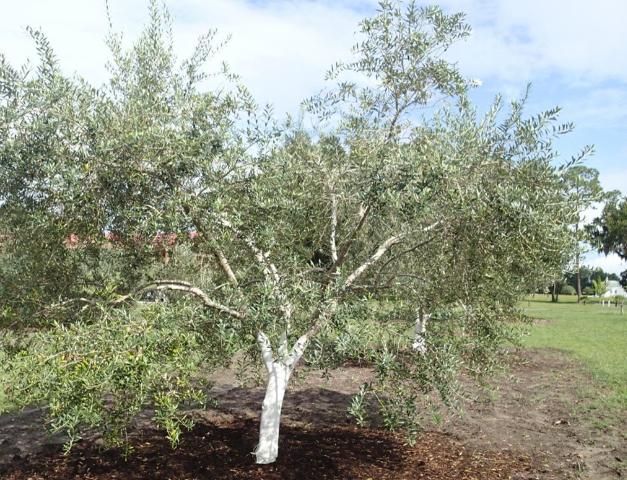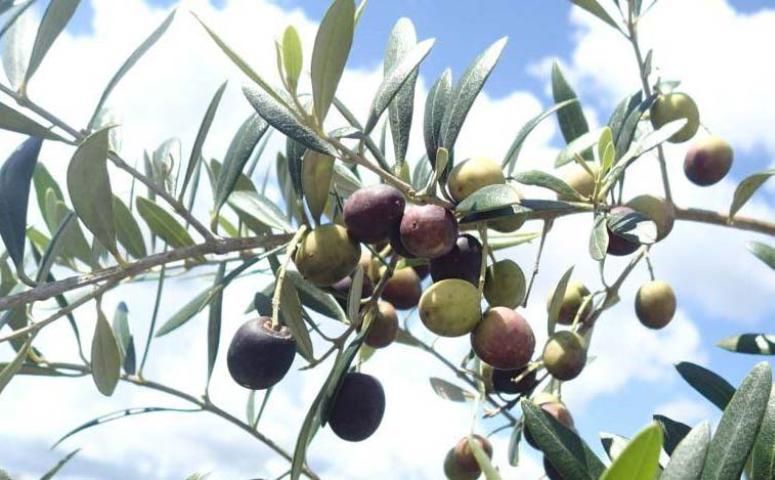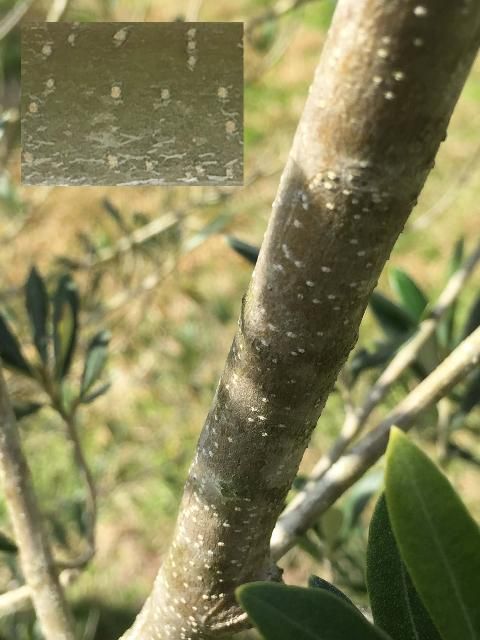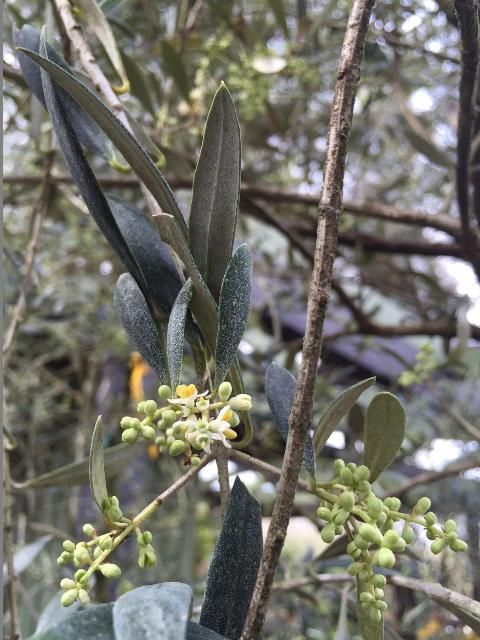Olives (Olea europaea) have great potential as a landscape ornamental and may also provide opportunities for home fruit production. However, as a relatively new commercial crop to Florida, the cultural requirements of these trees are not completely known and research is ongoing to understand how to manage them for plant health and fruit yield as well as to make recommendations on varietal selections best suited to the southeastern region of the United States. A selection of olive cultivars currently available in the United States that have been imported from traditional olive growing regions of the world is listed in Table 1.
Description
Olive is an evergreen tree of the Olive family (Oleaceae) (Figure 1). Leaves are opposite and elliptical with a narrow apex that is sharply pointed (Figure 2). Leaf color is variable but is generally described as gray-green on the upper surface and much lighter on the lower surface; sometimes appearing almost white to silver. The leaves are this color on the underside owing to the presence of many scale-like hairs that trap moisture in the leaves. As with many evergreen species, the two- to three-year-old leaves usually fall at the same time new growth appears in the spring.

Credit: Jennifer L. Gillett-Kaufman, UF/IFAS

Credit: Jennifer L. Gillett-Kaufman, UF/IFAS
The stems are initially gray-green, becoming tan to gray-tan as they mature. Olive stems have the characteristic corky lenticels (a lens-shaped pore, see Figure 3) that are common of plants in the Olive family. As stems become larger with age the bark becomes very irregular, and the trunk of the tree may also become somewhat enlarged.

Credit: Jennifer L. Gillett-Kaufman, UF/IFAS
Olive production in Florida has occurred for many years (FSHS 1907) with a few farms successfully producing fruit on a small scale. In recent years, interest in larger-scaled high-density production has increased in Florida, and new orchards have the potential to produce olives for the fruit and oil markets. Homeowners now have the opportunity to purchase olive trees for their landscapes from local growers and from large retail stores.
Culture and Management
Olives may be established in many areas of Florida in well-drained soils. While olives grow well on almost any well-drained soil up to a pH of 8.5 and are tolerant of mild saline conditions, sand-dominated soils are best as olives are susceptible to root rot diseases in moist or wet soils. Avoid planting olives in low areas where standing water accumulates after rainfalls.
Nutrient requirements for olive are low, and the trees do not produce well on highly fertile soils. Olive is a rapidly growing plant, and while growth increases are possible with supplemental nitrogen (N) fertilization, too much N will cause excessive vegetative (shoot) growth at the expense of reproductive growth (fruiting). Although nutrient deficiencies are uncommon, excessive N will negatively affect fruiting and oil quality. It is anticipated that management problems in Florida likely will involve excessive water and fertilization. Learn more about olive fertilization requirements by reading Guide to Olive Tree Nutrition in Florida (https://edis.ifas.ufl.edu/publication/ag405).
Olives are thought to be a relatively pest- and disease-free tree in much of the world, with the exception of a few invasive species that have become pests of olives in the last few years. Home gardeners will have few complaints about pests unless they cause an aesthetic injury like leaf discoloration or leaf damage. In Florida, many landscape trees are susceptible to scale insects, which secrete honeydew that leads to the growth of sooty mold. As the name implies, sooty mold is a black soot-like mold, which feeds on the honeydew accumulating on leaves, stems, and nearby surfaces. Leaf injury also can be caused by feeding damage by caterpillars or grasshoppers. Learn more about pests and fungal diseases of olive by reading Pests and Fungal Organisms Identified on Olives (Olea europaea) in Florida (https://edis.ifas.ufl.edu/publication/in1046).
Tree spacing for home cultivation will be different than in commercial groves. Tree size should be considered during variety selection so as not to interfere with permanent structures on the property. If planted on highly fertile soils, canopies up to 30 ft may be achieved. Olives can also be maintained with appropriate pruning as hedges in various configurations with 8–10 ft between plants in a row. Common commercial spacing ranges from 8–20 ft (in row) x 16–25 ft (between rows), with an average hedgerow spacing of about 10 ft x 20 ft.
Olive leaves are relatively small and have a protective cuticle which slows water loss, allowing olives to survive extended dry periods. An overabundance of moisture may cause the flowers to drop and reduce fruit yield, and while irrigation can be managed easily, rainfall may influence this aspect of olive production. In general, olives may be grown where winter temperatures do not drop below 12°F; however, green fruits may be damaged at about 28°F, although ripe fruit will withstand somewhat lower temperatures. The relative hardiness of selected olive cultivars is shown in Table 1.
Because flowering occurs on new growth emerging from the growth of the previous season, pruning can be tricky. Pruning is important in regulating flowering and may be used to shape the tree to assist with fruit harvest and will also improve air movement to reduce fungal disease. Olive trees will respond to radical pruning to control either height or plant form, but the impacts on flowering and fruiting should be considered. The olive never bears fruit twice in the same place on a stem, so new growth each year is essential to flower and fruit production the following year. Olive generally is described as an alternate-year-bearing species, and thus fruiting is typically heavy every other year. In off years, pruning during flowering to remove non-flowering branches can increase fruit yield for home gardeners.
The fruit of olive is known as a drupe, a fleshy fruit with a stony seed in the center. Many olive cultivars are grown from cuttings or are grafted and will reach bearing age in about four years. Olive fruit generally are green and become blackish-purple when fully ripe, although some cultivars may remain green when ripe or turn a shade of copper-brown (see Figure 2). Fruit shape and size also vary considerably, with selections that are predictably round to oval or even elongated with a pointed end. Fruit size, oil content, and flavor characteristics vary considerably and may be predicted by cultivar. Fruit size may be increased somewhat by reducing the number of fruit per branch or thinning the crop. Thinning to two or three fruit per foot of twig is done soon after fruit set.
Olives typically are not eaten raw from the tree and are considered unpalatable as they contain an alkaloid that makes them bitter. Home processing recommendations from the University of California, Davis Extension Service are recommended for home processing of fruit. Instructions and recipes are available at https://anrcatalog.ucanr.edu/pdf/8267.pdf.
Floral Structure and Self-Sterility
Most olive varieties are somewhat self-incompatible and several have recently been shown to be self-sterile. Flowers are produced on small inflorescences that emerge in the axil of the leaf from portions of the stem that grew the previous season (Figure 4). The flowers typically open in April or May in Florida, but have been reported as early as February 20th. The individual inflorescence, known as a panicle, is highly branched, with 10 to 40 flowers on an individual inflorescence. Olive flowers are fertilized by wind-blown pollen. Several varieties of olive are self-fertile and may fertilize their own flowers with their wind-blown pollen. However, research has shown that some trees that may be self-fertile in the regions where they were selected and developed may become self-infertile when grown in another region of the world. These differences in reproductive compatibility can be influenced by both fall and spring weather conditions. Initiation of flowering time is driven by winter chilling for removing dormancy, and the duration of flowering is influenced by conditions during spring warming. Higher spring temperatures and rainfall during flowering have been shown to decrease the number of days of flowering. Pests, such as thrips, and diseases such, as anthracnose, can also impact flowers and fruit set.

Credit: Jennifer L. Gillett-Kaufman, UF/IFAS
Olive flowers have four green sepals, four white petals, two stamens, and a pistil containing a single carpel which will eventually become an olive if the flower is successfully pollinated. Floral development in the olive can be quite complex. Inflorescences produce some flowers that are staminate (have only male parts), some flowers that are pistillate (have only female parts), and some flowers that are hermaphrodite (have both male and female parts) but all can be on the same individual tree (an andromonoecious species). Flowers at the very tips and at primary branch points tend to be hermaphrodite and open earlier, whereas flowers arising in secondary branch points are mainly staminate and commonly are the last to release pollen. The position of the flower within the panicle correlates with time of pollen release and flower gender.
Researchers at the University of California, Davis found that the major cultivars of olives grown in California ('Manzanillo') and Spain ('Picual') are self-incompatible. Recent research in Spain has shown the 'Arbequina' is also self-incompatible. Other research shows that 'Mission' and 'Manzanillo' are cross–incompatible, as are many French cultivars and the varieties 'Kalamata', 'Pendolino', and 'Picual'. The olive cultivars 'Leccino', 'Pendolino', 'Moraiolo', and 'Maurino' are self-sterile and require a source of pollen from another cultivar. Multiple trees of the same clone (cultivar) would not be able to pollinate each other. Cross-pollination from two distinctly different olive cultivars can result in successful fertilization and fruit production, but some varieties are not capable of serving as pollinators (also called pollinizers) for each other. This complex relationship is the result of the floral structure of the olive combined with the need for both a cool period to initiate floral production and the effects of warming trends on the rate of floral development and pollination the following spring. For this reason, if fruit production is a primary objective of olive culture, at least two distinct cultivars should be planted in close proximity to each other to facilitate transfer of the wind-borne pollen. Interestingly, because so many people are allergic to olive pollen, many urban areas ban the planting of regular olive trees, so sterile non-flowering varieties like 'Swan Hill' and 'Wilsoni' are available.
Researchers have been studying the potential for cross-pollination among olive cultivars to better understand these complex relationships. The research has shown mixed results, apparently influenced by the environmental conditions where the plants are growing. Table 1 summarizes compatible and incompatible combinations that have been noted in other olive growing regions. The "Selected References Related to Reproductive Fertility in Olive" (below) are the primary sources for the preparation of Table 1 and in some cases provided conflicting information. While this is a good place to start when selecting olive cultivars for home fruit production, it is important to remember there has been little formal research to date investigating these compatibility relationships in Florida.
Selected References
Connell, J. H. and P. M. Vossen. 2007. "Organic Olive Orchard Nutrition." In Organic Olive Production Manual, edited by P. M. Vossen, 107. Oakland, CA: University of California, Agricultural and Natural Resources, Communication Services.
Florida State Horticulture Society (FSHS). 1907. "Question Box." Proceedings of the Florida State Horticulture Society 20:133–137. Accessed February 6, 2023. https://journals.flvc.org/fshs/article/view/103868/99791
Gillett-Kaufman, J. L., S. A. Allan, J. H. Bosques-Mendez, and L. J. Buss. 2014. Pests and Fungal Organisms Identified on Olives (Olea europaea) in Florida. IN1046. Gainesville: University of Florida Institute of Food and Agricultural Sciences. https://edis.ifas.ufl.edu/publication/in1046
Moral, J. and A. Trapero. 2009. "Assessing the Susceptibility of Olive Cultivars to Anthracnose Caused by Colletotrichum acutatum." Plant Disease 93(10):1028–1036. https://doi.org/10.1094/PDIS-93-10-1028
Mulvaney, M. J., Mylavarapu, R., Andersen P. C., Thetford, M. and J. L. Gillett-Kaufman. 2016. Guide to Olive Tree Nutrition in Florida. SS-AGR-402. Gainesville: University of Florida Institute of Food and Agricultural Sciences. https://edis.ifas.ufl.edu/publication/ag405
Ortiz, M. S. 1982. "Thrips tabaci Lindeman as a Problem in Olive Groves." Revista Peruana de Entomologia 23(1):167.
Vossen, P. M. 2007. "Olive Oil: History, Production, and Characteristics of the World's Classic Oils." HortScience 42(5):1093–1100.
Yada, S., L. J. Harris, G. York, and R. Vaughn. 2007. "Olives: Safe Methods for Home Pickling." University of California, Davis. Division of Agriculture and Natural Resources. Publication number 8267. Accessed February 6, 2023. https://anrcatalog.ucanr.edu/pdf/8267.pdf
Selected References Related to Reproductive Fertility in Olive
Aparicio-Ruiz, R. and J. Harwood (eds.). 2013. Handbook of Olive Oil: Analysis and Properties. New York: Springer Science+Business Media. doi: 10.1007/978-1-4614-7777-8_1.
Cuevas, J., A. J. Díaz-Hermoso, D. Galián, J. J. Hueso, V. Pinillos, M. Prieto, D. Sola, and V. S. Polito. 2001. "Response to Cross-Pollination and Choice of Pollinisers for the Olive Cultivars (Olea europaea L.) 'Manzanilla de Sevilla', 'Hojiblanca' and 'Picual'." Olivae 85:26–35.
Cuevas, J, V. Pinillos, and V. S. Polito. 2009. "Effective Pollination Period for 'Manzanillo' and 'Picual' Olive Trees." Journal of Horticultural Science and Biotechnology 84:370–374.
Diaz A, A. Martin, P. Rallo, D. Barranco, and R. De La Rosa. 2006. "Self-Incompatibility of 'Arbequina' and 'Picual' Olive Assessed by SSR Markers." Journal of the American Society for Horticultural Science 131:250–255.
Farinelli, D., P. Pierantozzi, and A. M. Palese. 2012. "Pollenizer and Cultivar Influence Seed Number and Fruit Characteristics in Olea europaea L." HortScience 47:1430–1437.
Fernández-Escobar, R. and G. Gómez-Valledor. 1985. "Cross-Pollination in 'Gordal Sevillana' Olives." HortScience 20:191–192.
Guerin J. and M. Sedgley. 2007. Cross Pollination in Olive Cultivars. Barton, Australia: Rural Industries Research and Development Corporation. Publication No 07/169.
Sánchez-Estrada, A. and J. Cuevasb. 2018. 'Arbequina' olive is self-incompatible. Scientia Horticulturae. 230:50–55. https://doi.org/10.1016/j.scienta.2017.11.018
Seifi, E., J. Guerin, B. Kaiser, and M. Sedgley. 2012. "Sexual Compatibility of the Olive Cultivar 'Kalamata' Assessed by Paternity Analysis." Spanish Journal of Agricultural Research 10(3):731–740.